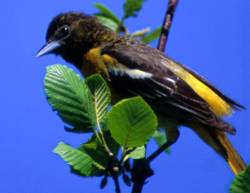Baltimore Oriole (Icterus galbula) - Wiki Baltimore Oriole
From Wikipedia, the free encyclopedia
[Photo] Adult male Baltimore Oriole (Icterus galbula) from US FWS. Title: Northern Oriole. Creator: Hollingsworth, John and Karen. Publisher: U.S. Fish and Wildlife Service. Rights: public domain
The Baltimore Oriole, Icterus galbula, is a small icterid blackbird which is 18 cm long and weighs 34 g. This bird received its name from the fact that the male's colors resemble those on the coat-of-arms of Lord Baltimore. The Baltimore Orioles, an American League baseball team in Baltimore, Maryland, were named after this bird. It is also the state bird of Maryland.
Adults have a pointed bill and white bars on the wings. The adult male is orange on the underparts, shoulder patch and rump. All of the rest of the male is black. The adult female is yellow-brown on the upper parts with darker wings, and dull orange on the breast and belly.
The male sings a loud fluty whistle that often gives away the bird's location before any sighting can be made. Click here to listen to the whistle of a Baltimore Oriole.
Distribution and ecology
The breeding habitats of these birds are the edges of deciduous and mixed woods across eastern North America. The range of this bird overlaps with that of the similar Bullock's Oriole in the midwest, and the two species are sometimes considered to be conspecific under the name Northern Oriole because they form fertile hybrids.
These birds migrate in flocks to southern Mexico, Central America and northern South America. Some birds may remain near feeders in winter.
The Baltimore Oriole's nest is a tightly woven pouch located on the end of a branch, hanging down on the underside.
The Baltimore Oriole is a rare vagrant to western Europe, and there are a couple of British records of birds wintering near garden feeders, including one in Oxford in December 2003. Perhaps the most remarkable record was the incident occurring on 7th and 8th of October, 2001. On this date, in Baltimore, Co. Cork, Ireland, the first record of this species in Ireland was made.
Baltimore Orioles forage in trees and shrubs, also making short flights to catch insects. They mainly eat insects, berries and nectar, and are often seen sipping at hummingbird feeders. Oriole feeders contain essentially the same food as hummingbird feeders, but are designed for orioles, and are orange instead of red and have larger perches. Baltimore Orioles are also fond of halved oranges and, in their winter quarters, the red arils of Gumbo-limbo (Bursera simaruba).
http://en.wikipedia.org/wiki/Baltimore_Oriole
| The text in this page is based on the copyrighted Wikipedia article shown in above URL. It is used under the GNU Free Documentation License. You may redistribute it, verbatim or modified, providing that you comply with the terms of the GFDL. |
